Historically, so many problems have occurred with parapets that we have a name for it: “parapetitus.” They have a long history—which of course is not always clear—that allows me to embellish without threat of peer review reversal.1 Their major function today, aside from confusing architects, is to protect the edge of roof assemblies from wind uplift forces. Not so in the old days where they were useful in fire protection.
When wind blows against a building it produces vortices at the roof edges (Figure 1) that create huge pressure differences (Figure 2) at roof perimeters that can suck roofs off buildings. Parapets dramatically reduce these pressure differences at roof edges (Figure 3). Neat eh? All this from a University of Toronto guy, go Varsity Blues (Leutheusser, H.J., 1964(2)).
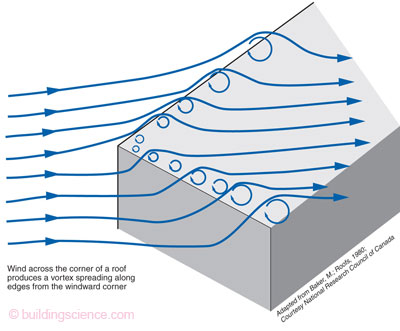
Figure 1: Roof Edge Wind Effects—When wind blows against a building, it produces vortices at the roof edges.
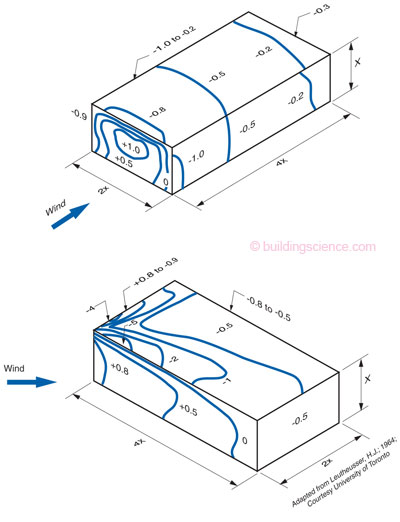
Figure 2: Pressure Differences—Notice the large pressures at roof perimeters. From Leutheusser(2) and the Department of Mechanical Engineering, University of Toronto, 1964. Some of us recall that 1964 was a good year. The Toronto Maple Leafs won the Stanley Cup. Tim Horton played defense on that team long before he got into the donut business.
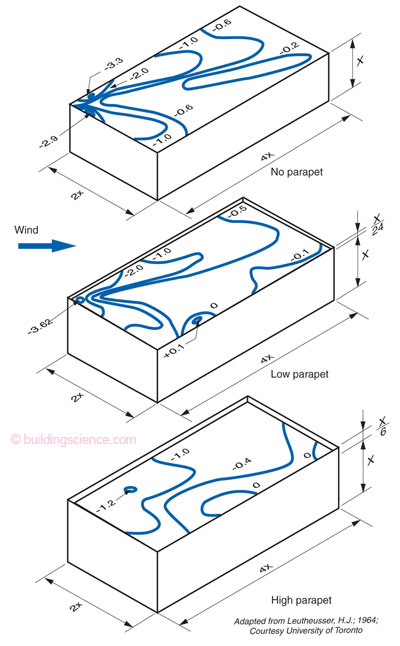
Figure 3: Effect of Parapets on Pressure Differences—Parapets dramatically reduce these pressure differences at roof edges. This is from a beautiful bit of work from Leutheusser at my alma mater the University of Toronto. Of course, this happened in 1964, more than a decade before I got there. I am old, but not that old.
The easiest thing to get right about parapet construction is to keep rainwater from getting into the top of them. The principles are easy. Slope the top of them inward so they don’t stain the building façade. Make sure that there is a waterproof membrane under the coping. Always. Metal and stone copings leak at joints. And always have drip edges—front and back—so that they don’t stain the building façade. Did I mention the staining of the building façade? Check out Figure 4 and Photograph 1 to see it done right. If you want to get depressed, look at Photograph 2.
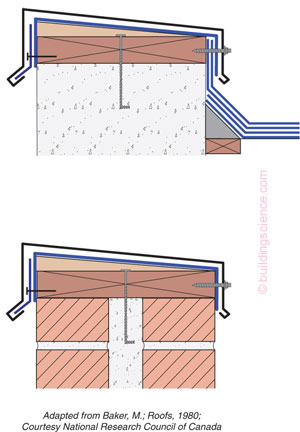
Figure 4: Parapet Water Management—Keep rainwater from getting into the top of them. Slope the top of them inward so they don’t stain the building façade. Make sure there is a waterproof membrane under the coping. And always have drip edges—front and back—so they don’t stain the building façade.
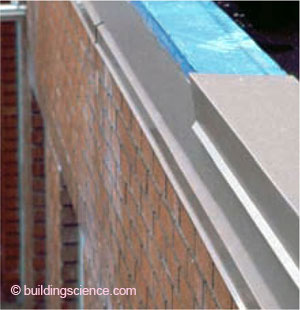
Photograph 1: Excellent Water Management—Notice the membrane under the coping. Notice the slope to the interior. And, notice the drip edges.
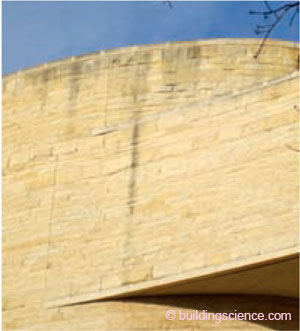
Photograph 2: Stains at Parapet—No drip edges. A beautiful building is becoming ugly.
Are we done yet? Nope, not by a long shot. Now it gets weird, not the physics, but why so many buildings get the physics wrong. For the physics we go to another one of those legendary old guys who got it right and made it simple for the rest of us to understand—Max Baker. Check out Figure 5, adapted from his book “Roofs.” Connect the water control element/layer of the roof to the wall, the air control element/layer of the roof to the wall, the vapor control element/layer of the roof to the wall and finally the thermal control element/layer of the roof to the wall. Sound familiar? Coming from me it should by now.2 I call them the “Baker Principles.”
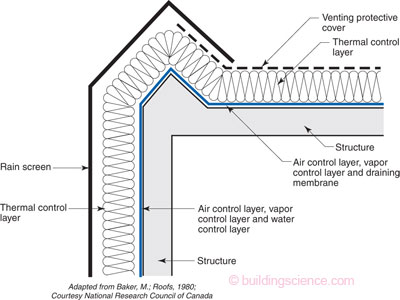
Figure 5: Parapet Physics—The “Baker Principles.” Adapted from the master, Max Baker.(1) Adapted how? I just updated the words, just the words, not the principles. Everyone relax. This is probably the most influential graphic in my building science education. When I first saw it, the lightbulb went off. Continuity of the control layers between roofs and walls is the whole enchilada.
This is what we typically get in the “real world” today (Figure 6). What a mess. No continuity of the four principle control layers:
Water control layer: no membrane under the parapet flashing;
Air control layer: no air control in either the roof assembly or the wall assembly;
Vapor control layer: same goes for the vapor control layer; and
Thermal control layer: thermal bridging everywhere.
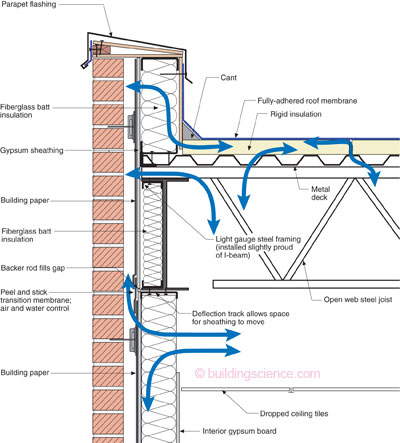
Figure 6: Problem Parapet—This is what I see on a regular basis. Everything is wrong. Air leakage into and out of everything and everywhere. No membrane under the parapet flashing. No air control in either the roof assembly or the wall assembly. No vapor control layer and thermal bridging everywhere.
And to make matters worse, structurally we also tend to have some issues. Ah, but not in the way you think. Think about the thermal stress a roof membrane goes through (Figures 7 and 8). The key is to transfer these stresses to the roof deck. In the old days it was easy; just fully adhere the roof membrane with a lot of goop directly to the structural deck so that each square foot of roof membrane stress was directly transferred to the square foot of structural deck directly under the membrane. No problem. Until, wait for it, some lunatic person introduced thermal insulation. Now we had to transfer the stress of the membrane through sometimes multiple layers of insulation before it got to the structural deck (Figure 9). If you didn’t get it right, you concentrated the stresses at roof edges, and you could suck in a parapet (Figure 10) or tear or rip a membrane at the parapet (Photographs 3 and 4).
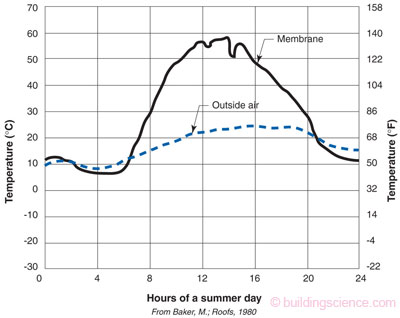
Figure 7: Roof Membrane Temperatures—Ottawa, Canada, summer day. Courtesy of Max Baker and the National Research Council of Canada.(1)
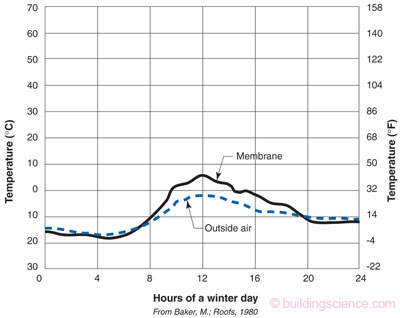
Figure 8: Roof Membrane Temperatures—Ottawa, Canada, winter day. Courtesy of Max Baker and the National Research Council of Canada.(1)
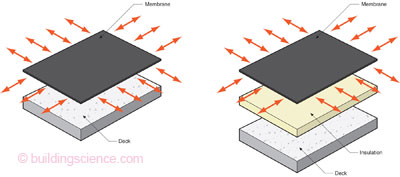
Figure 9: Transferring the Thermal Stress—Easy to do when the membrane is adhered directly to the structure. Not so easy when you have insulation, or worse, multiple layers of insulation between the membrane and the structure.
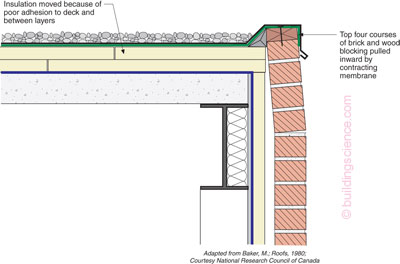
Figure 10: Collapsed Parapet—A parapet having a bad day.
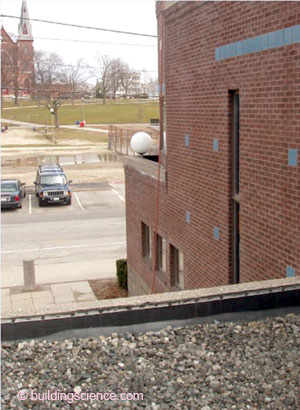
Photograph 3: Membrane Shrinkage—Notice the roofing membrane being pulled away from the cant strip.
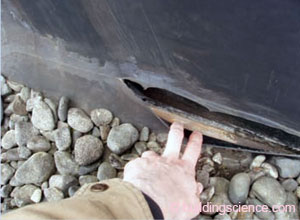
Photograph 4: Tear in Membrane—Membrane shrinkage results in the membrane pulling apart.
Transferring loads in multilayer compact roofs is quite controversial. There are lots of opinions, and I want to point out right from the start that only I am right. Let’s start out in the field of the roof. This is how a compact roof would be constructed if I was in charge (Figure 11). There should be a continuous fully adhered air control layer supported by gypsum sheathing on the top of a metal deck.3 The gypsum sheathing is screwed to the metal deck. There should be a whole bunch of rigid thermal insulation on the top of this air control layer—in two layers at least with the joints off-set horizontally and vertically.4 This insulation should be screwed down to the metal deck. Then on top of the rigid thermal insulation there should be a coverboard. This coverboard is also screwed down to the metal deck. Finally, a roof membrane is fully adhered to the coverboard.
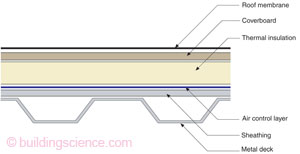
Figure 11: Perfect Compact Roof—The roof I would build if I were in charge. A continuous fully adhered air control layer supported by gypsum sheathing on the top of a metal deck. The gypsum sheathing is screwed to the metal deck. Rigid thermal insulation on the top of this air control layer in two layers at least with the joints off-set horizontally and vertically. This insulation should be screwed down to the metal deck. Then on top of the rigid thermal insulation there should be a coverboard. This coverboard is also screwed down to the metal deck. Finally, a roof membrane is fully adhered to the coverboard.
The function of the coverboard is two-fold. First, it is a hygric buffer that reduces roof membrane blistering. A discussion of this has to wait for some other time. Second, and most important to our story, is that its function is to transfer the stresses of the primary roof membrane to the metal deck. Stresses from the roof membrane are transferred to the coverboard, and the coverboard does the heavy lifting and handles these stresses finally getting them down to the metal deck.
Next we have to deal with the potential for concentrated roof stresses at parapets. Figure 12a shows how the “old timers” did it—wood blocking and a cant anchored to the structural deck. Figure 12b shows how the “new pups” do it—a large backer rod supporting a bunch of extra membrane that lets things move when they have to move. As much as it pains this “old timer” to say this, with the newer more dimensionally stable membranes the “new pups” have it more right.
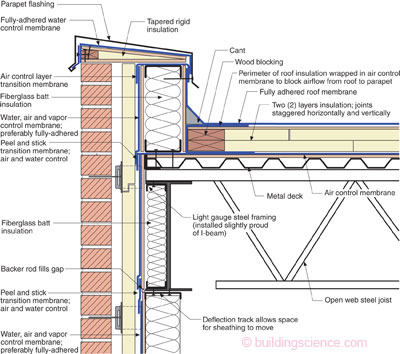
Figure 12a: Steel Stud Parapet “Old Timer.”—Wood blocking and a cant anchored to the structural deck restrain membrane shrinkage at parapet. Notice the continuity of the control layers.
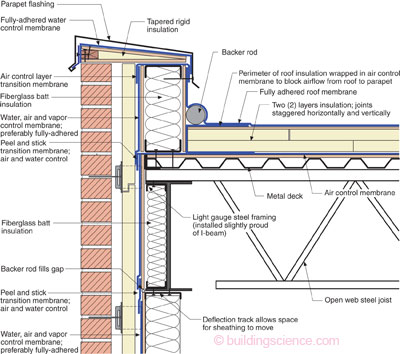
Figure 12b: Steel Stud Parapet “New Pups.”— Large backer rod supporting a bunch of extra membrane that lets things move when they have to move. The “Zen” approach to membrane movement. Use a more dimensionally stable membrane and then let things move when they have to. Again, notice the continuity of the control layers.
Now on to the continuity stuff. All we have to do is apply the Baker Principles (Figure 5) to typical roofs and walls. To that end, with the help of my colleagues at the Skunk Works at Building Science Corporation, I have drawn up a few of the more common parapet constructions following the “Baker Principles”: the already discussed Steel Stud Parapet (Figure 12b), the Masonry Parapet (Figure 13), the Balloon Framed Steel Stud Parapet (Figure 14) and, finally, the Cantilevered Mini Parapet (Figure 15).
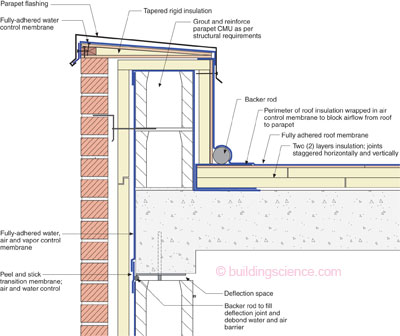
Figure 13: The Masonry Parapet—The thing to note here is that the concrete deck is the air control layer so an additional one is not necessary. However, joints in the concrete deck need to be addressed for air control layer continuity.
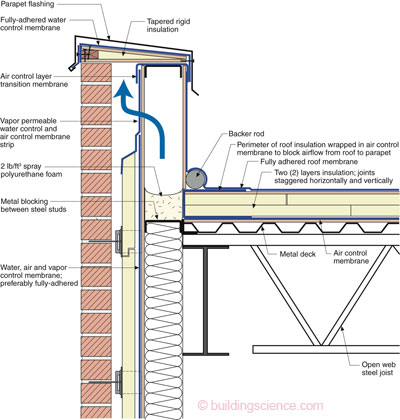
Figure 14: The Balloon Framed Steel Stud Parapet— This is the ugliest parapet to get right. Notice the use of spray polyurethane foam, the high density stuff, to provide air control layer continuity across the balloon framed exterior steel stud wall. The spray foam is supported by horizontal bridging or metal blocking. This is a tricky thing to execute and, as such, we design into the upper parapet assembly a pathway for drying via diffusion to provide some performance redundancy.
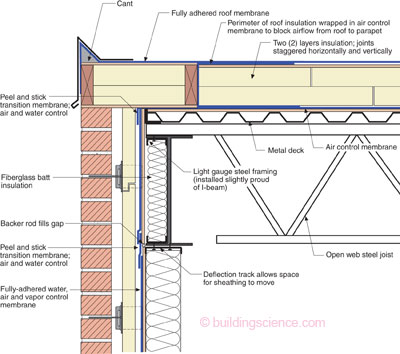
Figure 15: The Cantilevered Mini Parapet—Notice that air control layer continuity is achieved by wrapping the membrane over the building corner and then constructing the cantilevered portion of the parapet over the top of this air seal.
All of the “good” series of parapet details presented follow the “Baker Principles” and a little bit of other stuff (Figure 12a, Figure 12b, Figure 13, Figure 14, and Figure 15):
- Water control layer continuity: membranes continuous under the parapet flashing;
- Air control layer continuity: an air control layer in the roof assembly is connected to the air control layer in the wall assembly;
- Vapor control layer continuity: a vapor control layer in the roof assembly is con¬nected to the vapor control layer in the wall assembly;
- Thermal control layer continuity: the thermal control layer of the roof assembly is connected to an effective thermal control layer in the wall assembly. The thermal control layer in the wall assembly is exterior to the structure—just as in the roof assembly.
- The roof membrane is fully adhered to a coverboard that is mechanically attached to the structural deck in the field of the roof and an allowance for membrane movement is provided at the perimeter of the roof assembly.
The perimeter of the roof assembly insulation is wrapped to prevent interstitial airflow from the parapet into the multilayered rigid insulation of the field of the roof.
The cure for “parapetitus” is continuity of the control layers and letting things move when they have to move. Max Baker and Stonewall Jackson would be proud.
Footnotes:
The Italians have claim to the word “parapetto,” which comes from “parare,” which means “to defend,” and “petto,” which means “breast.” The military calls “parapet fortifications”—defensive stonewalls—“breastwork.” The dictionary meaning of “breasted” means “to confront boldly.” So, low stonewalls historically are called parapets and are military in origin. “Stonewall Jackson” was also called “Parapet Jackson.” OK, so that’s not true, but with the way textbooks seem to be written today I bet I could get away with it if I decided to write one. So how did they come to be located on the edge of roofs? Ah, we can thank the English for that. In the old days, London tended to keep burning down and that tended to irritate the folks who lived in London. So, projecting wooden eaves were banned in the Building Act of 1707 as a fire risk. Instead an 18 in. brick or stone parapet was required, with the roof set behind, as fire protection (http://en.wikipedia.org/wiki/Parapet).
Check out “BSI-001: The Perfect Wall.” It was my first column for ASHRAE and it was inspired by Max Baker’s marvelous book Roofs.(1) The book, now out of print, was sponsored by the National Research Council of Canada and it brought together information into one document from Canadian Building Science Digests, Research Papers and Building Science Seminars and Workshops from the Division of Building Research. Much of this information is online (http://tinyurl.com/2eezyth). Awesome.
For a more interesting discussion about the need for air barriers in compact roof assemblies, check out ASHRAE Journal, March 2008, “How Not to Build Roofs” or “BSI-019: Uplifting Moments-Roof Failures.”
To more fully appreciate the need to offset the rigid insulation joints horizontally and vertically and to wrap the perimeter of the roof assembly insulation check out “BSI-036: Complex 3-D Airflow Networks.”
